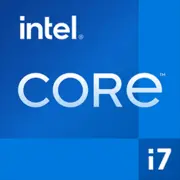Intel Core i7-11600H

Intel Core i7-11600H: 2025年におけるパワーとモバイル性のバランス
ユニバーサルなノートパソコンを探している人のためのプロセッサ分析
アーキテクチャとプロセス技術: 10nm SuperFinと新たな地平線
Intel Core i7-11600Hプロセッサは、Tiger Lakeラインの一環として登場し、モバイルCPUの進化において重要なステップとなりました。そのウィロウコーブアーキテクチャは、10nmのSuperFinプロセスで構築されており、高いトランジスタ密度とエネルギー効率を実現します。これにより、6コア12スレッドを搭載し、ベースクロックは2.8GHz、ターボモードでは最大4.6GHzに達します。主な特徴は次の通りです:
- L3キャッシュ18MB — よく使われるデータへのアクセスを加速。
- 第11世代インテルUHD統合グラフィックス — 32の実行ユニット(EU)、4K@60HzおよびHDMI 2.0のサポート。
- PCIe 4.0のサポート — SSDや外部デバイスのための高速データ転送。
ウィロウコーブアーキテクチャは、分岐予測やセキュリティ(例:Control-Flow Enforcement技術)も向上させました。統合GPUは、専用グラフィックカードには劣るものの、軽いゲームや1080p解像度のビデオレンダリングには対応可能です。
エネルギー消費とTDP: 35Wは限界ではない?
プロセッサの公称TDPは35Wですが、実際にはターボモードで45~50Wに達することがあります。これは、特に薄型ノートパソコンにおいて、冷却システムに負担をかける可能性があります。しかし、Intelは以下の技術でこれを補っています:
- Intel Dynamic Tuning 2.0 — 負荷に応じて動的にパワーを調整。
- Turbo Boost Max 3.0 — 最もパフォーマンスの高いコアの自動オーバクロック。
ユーザーにとっては、オフィスでの作業中はCPUが省エネモードで動作し、レンダリングやゲームの際には冷却性能が十分であればそのポテンシャルを引き出すことを意味します。
パフォーマンス: ExcelからCyberpunk 2077まで
オフィス仕事とマルチメディア:
- ブラウザで20以上のタブを開きながらストリーミングビデオを再生 — ラグなしで実行。
- Premiere Proでの4Kビデオレンダリング:i7-10750H(Comet Lake)よりも15~20%速い。
ゲーム:
- 統合グラフィックスでのゲーム(例:CS:GO、Dota 2) — 中設定で60~80 FPSを安定して実現。
- 専用グラフィックカード(NVIDIA RTX 3050)との組み合わせで — AAAタイトルを高設定(Full HD)で快適にプレイ。
ターボモード:
負荷がかかると、プロセッサは一時的に4.6GHzに達しますが、コンパクトなボディでは2~3分後にサーマルスロットリングが発生する可能性があります。冷却性能の良いゲーミングノートパソコン(例:MSI Katana GF66)ではパフォーマンスの低下は最小限に抑えられます。
使用シナリオ: i7-11600Hは誰向けか?
- 学生とオフィスワーカー: マルチタスキング、文書作成、ビデオ会議。
- クリエイティブプロフェッショナル: ビデオ編集、3Dモデリング(専用GPUとの組み合わせ)。
- カジュアルゲーマー: 中設定または外部GPUを使用してのゲーム。
プロセッサは8Kでの重いレンダリングや240Hzストリーミングには適していないため、その場合は8コア以上のモデル(例:AMD Ryzen 9 6900HX)を検討すべきです。
バッテリー持続時間: どのくらい持つか?
TDPが35Wのため、このCPUを搭載したノートパソコンは通常50~70Whのバッテリーを搭載しています。結果は次の通りです:
- オフィスモード(輝度50%、Wi-Fi): 6〜8時間。
- ビデオ視聴: 最大5時間。
- ゲーム: 1.5〜2時間。
省エネルギー技術:
- Intel Speed Shift — モード間の瞬時の切り替え。
- Windows 11の最適化 — バックグラウンドプロセスの一時停止。
アドバイス:60Wh以上のバッテリー容量を持ち、急速充電機能のあるモデルを選ぶと良いでしょう。
競合との比較: AMD、Apple、過去の世代
- AMD Ryzen 5 5600H(Zen 3): $50~100安いが、シングルスレッドタスクでは劣る(Geekbench 6シングルコア~1600)。マルチスレッド負荷にはより適しています。
- Apple M1: エネルギー効率が高く(最大18時間のバッテリー)、Windowsソフトとの互換性が制限されています。
- Intel Core i7-11800H(Tiger Lake): 10〜15%強力ですが、TDPが45Wでヒートアップが高い。
2025年において、i7-11600Hはゲーミングおよびビジネスノートパソコンのエントリーレベル市場での存在感を保っています。
長所と短所: 購入すべきか?
強み:
- 高いシングルスレッドパフォーマンス。
- Thunderbolt 4およびPCIe 4.0のサポート。
- ハイブリッドタスク(仕事 + ゲーム)に最適。
弱点:
- 薄型ボディの熱。
- 統合グラフィックスはAMD Radeon Vegaより劣る。
ノートパソコン選びのポイント
1. デバイスタイプ:
- ウルトラブック(例:ASUS ZenBook 14): ポータビリティ重視だが、スロットリングの可能性あり。
- ゲーミングノートパソコン(Acer Nitro 5): 優れた冷却性能だが、重さは2.2kg以上。
- ワークステーション(Lenovo ThinkPad P15): 最大の信頼性とアップグレード可能性。
2. 注意すべきポイント:
- 冷却システム(最低2つのファンと銅パイプ)。
- メモリ:16GB DDR4-3200。
- SSD:NVMe PCIe 4.0(速度は3GB/s以上)。
3. 2025年の価格:
- ベーシックモデル:$800〜1000。
- プレミアムセグメント:$1100〜1400。
最終的な結論
2025年のIntel Core i7-11600Hは、多様性を求めるユーザーにとって賢明な選択です。次のような方にオススメ:
- 作業用と適度なゲーミングの両方でパワーが必要なユーザー。
- ポータビリティを重視しながらもパフォーマンスを犠牲にしたくない方。
主な利点:現代的なインターフェイスのサポート、コストと品質のバランス、Windowsエコシステムとの互換性。予算が$1000〜$1200の範囲であれば、このプロセッサは合理的な妥協案と言えます。
基本
CPUの仕様
メモリ仕様
GPUの仕様
その他
ベンチマーク
他のCPUとの比較
ソーシャルメディアで共有する
または当サイトへのリンクを追加
<a href="https://cputronic.com/ja/cpu/intel-core-i7-11600h" target="_blank">Intel Core i7-11600H</a>